Bob was keen for some more passes of Narrow Neck and as neither of us had been up or down Diamond Head Pass – we decided that this should be one that was visited. It would link up nicely with Redledge Pass.
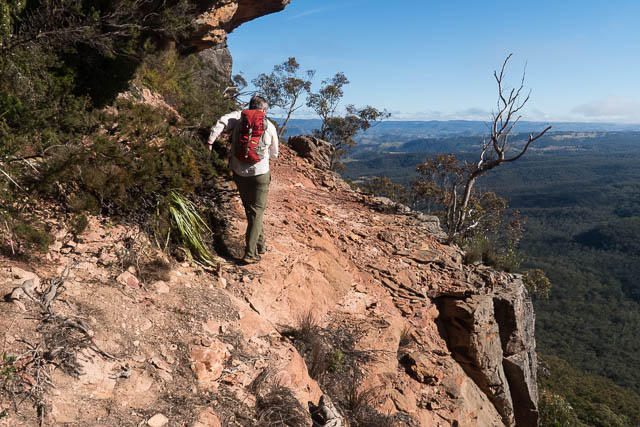
Here, I am using the name “Diamond Head” for the headland of Narrow Neck between Diamond Creek and Corral Creek.
Diamond Head Pass is perhaps one of the less frequently visited passes of Narrow Neck. I had seen what I thought was a viable pass up the lower cliffline at Diamond Head on an earlier (2005) trip to Redledge Pass and the Devils Hole. This was from the old tramway below the head. To me, it looked possible to scramble up the point at the lower cliffline and then traverse on the half-way ledge towards Diamond Creek, until it was possible to scramble up through the top cliffline. This observation was confirmed by looking at Jim Barrett’s monograph on Narrow Neck – Narrow Neck and the Birth of Katoomba (1996) – page 54. And, more recently Tom and Rachel Brennan had ascended this pass.
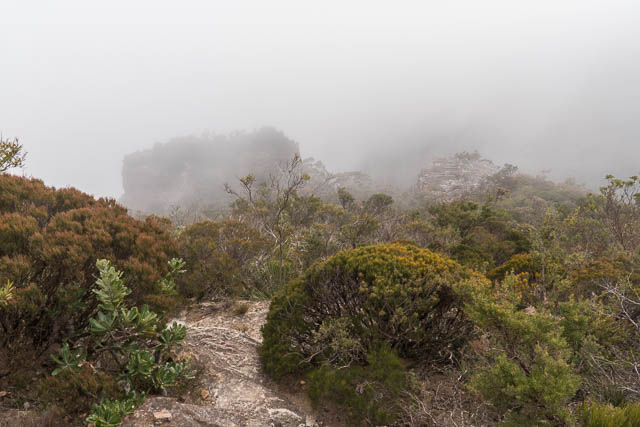
To access the half-way ledge, we used the rock climbers access track to the Diamond Falls Climbing Area. This conveniently leaves from the car park at the barrier on Narrow Neck. It was misty when we set out, but it was easy to follow the track down an easy pass to a point and then follow along a ledge back towards Diamond Falls.
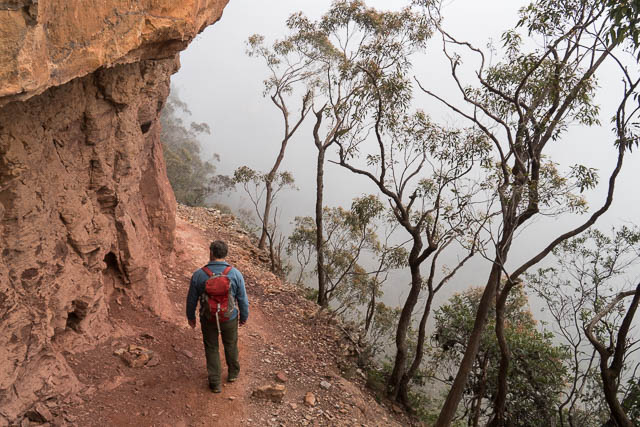
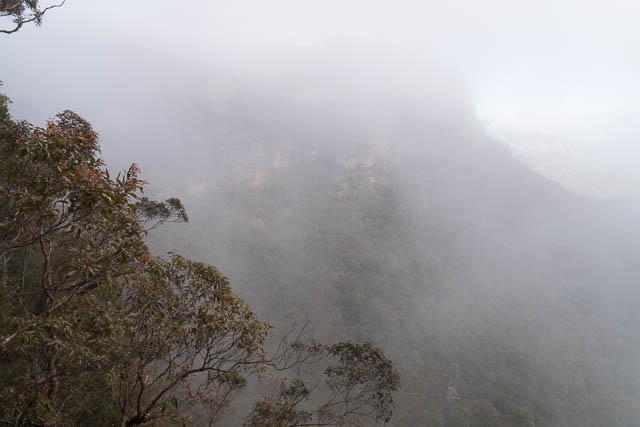
Along the way, we passed the climbing area – steep sports climbs. We then continued under Diamond Falls and found it easy going on the far side. There seemed to be a rough pad most of the way. In caves we spotted the odd footprint. Not far past the waterfall, we came across a rope hanging down from what looked like an easy pass back up through the top cliffline. We didn’t climb up – so cannot confirm that it goes. But, I would expect the top to be quite scrubby, and it is probably much easier to use our route through the climbing area.
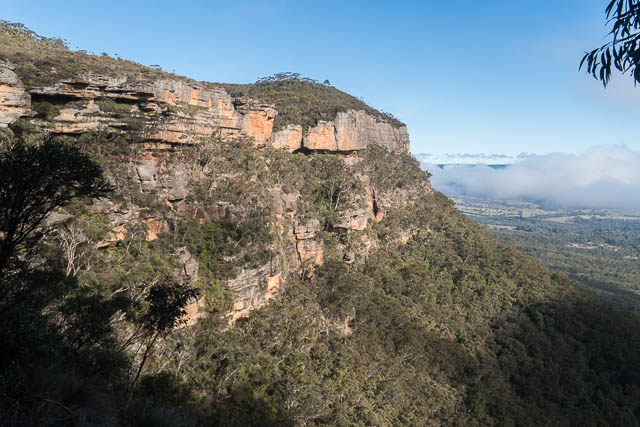
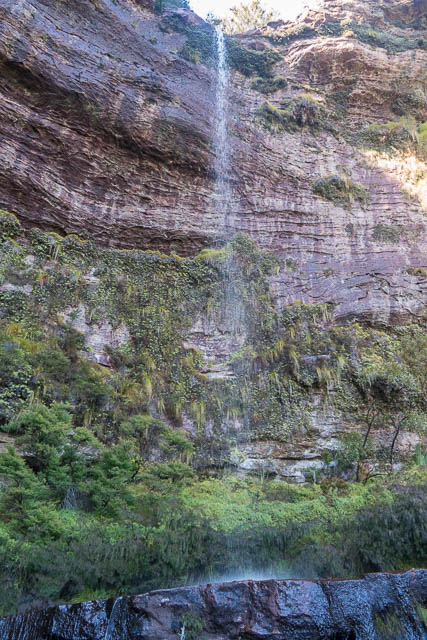
Diamond Falls
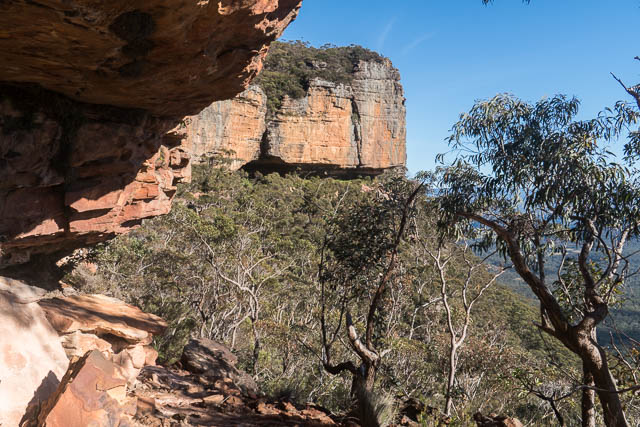
A bit further we came across a hollow rock pile in a cave. It seemed to serve no purpose.
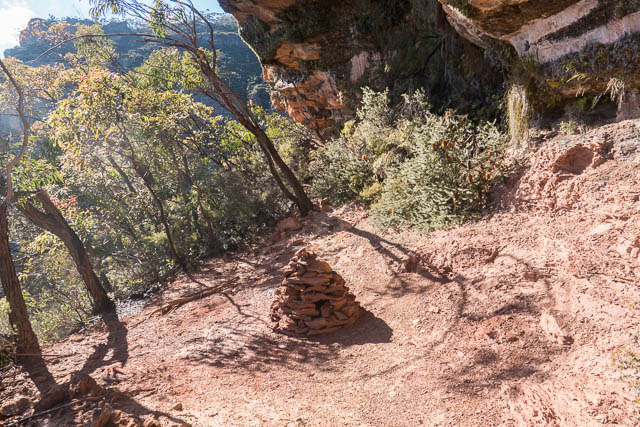
As we approached the point – the end of Diamond Head, we started scouting out below. The cliffs seemed to be breaking up a bit. Looking around the corner showed that here the ledge ended, so we should have to descend or go back.
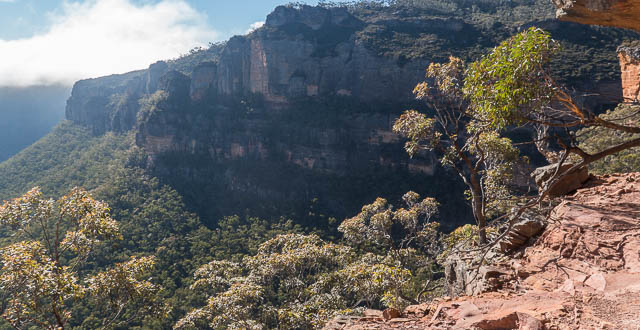
Bob had a scrambling rope, which we used to get down the first bit of the cliff. But we could have avoided using the rope – Bob didn’t use it when he climbed back up to get his pack. Lower down was another steep bit – we stayed closer to the nose, and didn’t use the rope. The next bit looked trickier. We set up the rope and did a short abseil – perhaps about 6 m? Bob went first, and later waiting at the bottom out of the way of rocks, he reported that it looked easy to scramble back up via an exposed route closer to the nose.
Below, was another easy section, not so steep and then one more cliff that we managed to scramble down without too much trouble. That was all the difficulties.
We continued down the open, but steep slopes below – descending to the old shale tramway. On the way, we passed what looked to us like two collapsed shale mine adits. These were perhaps half way down to the tramway level. That they were old mines seemed to be confirmed by what we found further down – remains of an old man made path descending down at a southward diagonal to the slope. In places the steep facing side and been built up with rocks. It could have been once part of a haulage way or perhaps a chute? It is also possible that the miners accessed the site from the pass above. This area is quite distinct from the old shale mining area below Redledge Pass.
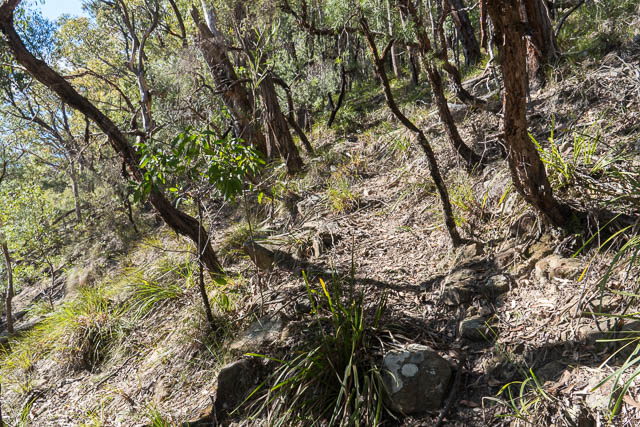
Lower down, we reached the old tramway formation. Here it is still very obvious. We followed it towards Corral Creek, crossed the creek and then continued a little further until we lost it, then started climbing up to Redledge Pass. We perhaps ascended too early, but higher up, we must have over-corrected a bit. We went under the cliffs a bit, then it looked like we had reached the bottom of the cleft up the lower cliffs, which is the bottom section of Redledge Pass. The cleft went easily, but didn’t seem familiar. There didn’t seem to be enough scuffle. On top, it looked like we had gone past the proper cleft of the pass and used an alternative one slightly further along. It didn’t seem to matter much.
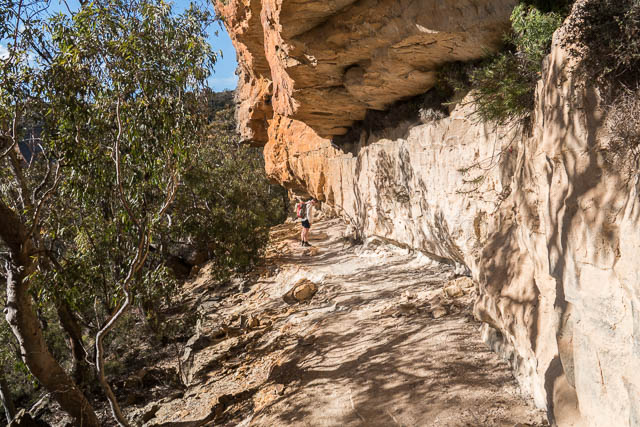
The red ledge of Redledge Pass provided great views, particularly of the “Big Hole” – a large cave high in the cliffs that had been visited, with some difficulty, by members of the Catholic Bushwalking Club back in 1986.
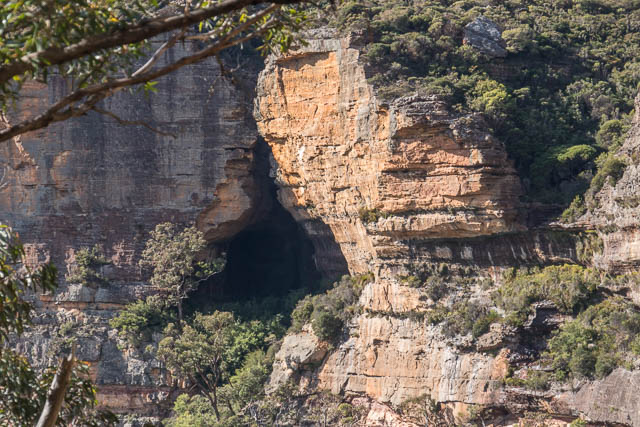
Around the corner, we found the logbook, it was almost full. We added an entry on the last page. If anyone is planning on visiting the pass then they may want to bring a new book out. The old book goes back about 20 years.
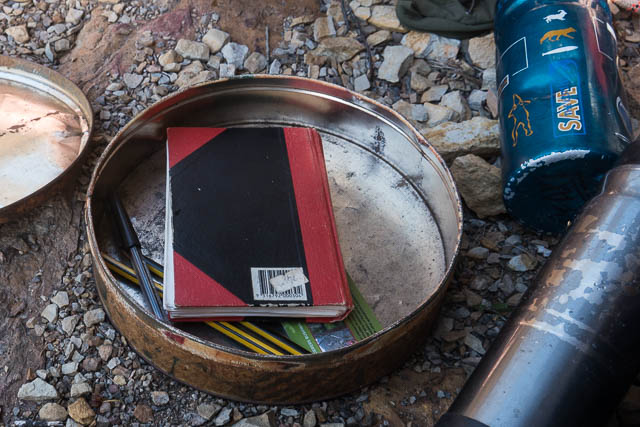
We had thought of heading up Corral Creek to look for the Skull Cave, a small cave reportedly used as a refuge by Professor Arbuthnot Skull many years earlier. Whether Prof Skull is a real person is doubtful. The waterfall at the end of Corral Creek has also been called “Lizards Leap”. Instead, we continued along the Redledge Pass track, through the heath back to the Narrow Neck Road. Part of the way along, the track crosses the old Narrow Neck Walking Track – which is now very overgrown.
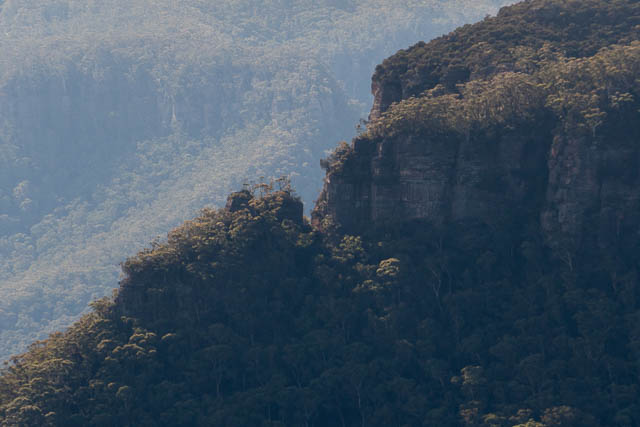
Megalong Head on Radiata Plateau
On the way back to Bob’s car, we visited two nice lookouts that provided great view of Mt Solitary. The first of these is reached from a track that leaves the Narrow Neck Road opposite where the Redledge Track meets the road.
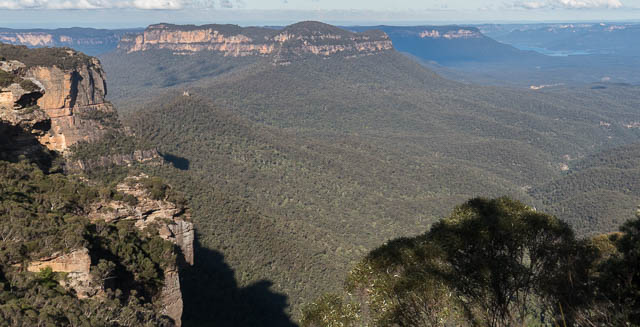
The second lookout is closer to the car park and also has some nice Aboriginal sharpening grooves.
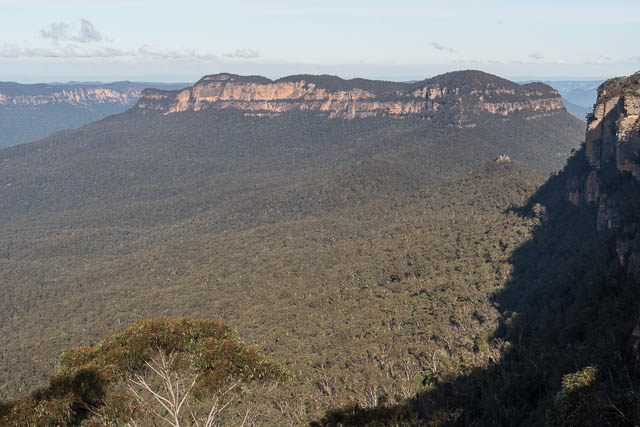
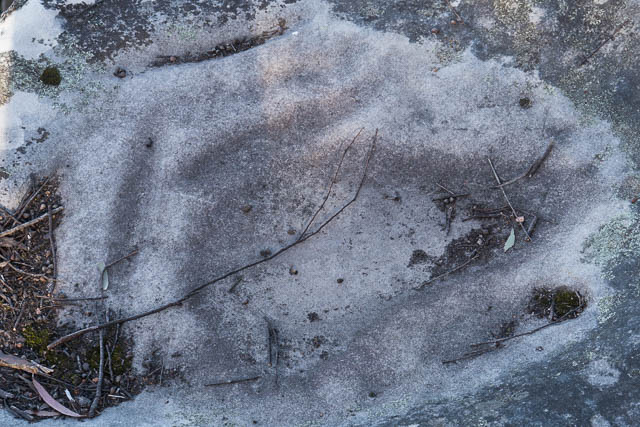
More photos from the walk are online here on my website.
Here is the gps trace from Bob –
[sgpx gpx=”/wp-content/uploads/gpx/2017-07-13-Walk.gpx”]
Update (18 Dec 2017) – Recently reading the biography of Ben Esgate (The Last of the Cox’s River Men, by Jim Smith, Den Fenella Press, 2006), there is mention of an ascent of “Anderson’s Head” on Narrow Neck during WW2 by members of the Volunteer Defence Corps – Lindsay Paish and Jack Collins (and perhaps others?). It seems Anderson Head is the same as the one I have referred to as “Diamond Head”. They found a reasonable easy way up to be stopped by a tricky top part – a 20 foot overhanging section. They eventually scrambled up this.

Would someone take me here to do this?
I discourage you from doing this if you do not feel confident and self sufficient in such terrain. Read my comment below.
Hi David,
I’ve done that walk yesterday: rainy then partly cloudy Sunday, cycling from Katoomba rail and saving bit time on CO2 emissions and money ($2.60 special return fare).
Fantastic news what little morning drizzle can do to upper heathland such on Narrow Neck: plenty of moisture and both Diamond & Corrsl Falls going strong but strangely creeks down at the tramway level still dry…
From Tom Brennan description it seems as while going up Diamond Head, Tom must have got confused and chose a more difficult route. No surprise because there are plenty of rock faces to navigate with fair bit of vegetation in between so you can get lost and don’t know where ascend (descending with a piece of rope is far easier).
The best ascending guideline is: from where the tramway intersects Diamond Creek, pick up the ridge going directly South. 100m or so below the cliff, you pass a medium Telopea bush (the only one I’ve seen there) which is a good orientation point. At the first cliffline go to the left and ascend an easy diagonal gully, then look for the largest banksia tree on top of the second, taller (~6-8m) cliffline (from which I abseiled). The “exposed scramble” is the diagonal, then upward trending ramp to the R of the tree. Bash through vegetation above the tree. Straight up is capped by unforgiving cliff so traverse around to the L and up and find the final 1-2 scrambles through lesser (than 5m high) cliffs .to the ledge and the path to Diamond Falls.
Overall the scramble looks no harder than say S end of Pantoneys. The challenge though is: the easiest line, needed to be doable without rope, is just difficult to find among various options and the vegetation. Eventually, the line will emerge if it is repeated. I’m hoping to climb it up next time I come back to the area. But I’m not encouraging anyone to do it because it requires both route finding and climbing skill and good nerves: don’t even attempt it if you haven’t done say Glenraphael Head without rope or you don’t feel confident on Carlons Chains.
Our route up the first couple of clifflines sounds the same – L to a gully, then up R and an exposed scramble to near a banksia, and crawl through vegetation. At the next cliffline we did go L, but the climbing ended up being harder than a scramble. From what I’ve read and heard, heading R might have been better, towards the nose.
Had a go today from above and can confirm there was no climbing or serious exposure necessary to get down – just a few steep scrambles with good holds if you take the right line. I would happily repeat it from below now that I know how safe that line was.
I have another comment David, about my experience ascending to Redledge Pass on my trip yesterday. You say you “over-corrected” to the R looking for the cleft. Actually, in my experience no “correction” is needed: I stuck precisely to the ridge behind Corral Ck. The ridge itself doesw not stay close to the creek but turns gently and brings you right to the centre of the cliff. On the way, I found 3 big red ribons, one ca 300m below cliff, one at the cliff and one shortly to R marking the start of the cleft ascent.
At the top I explored the other (SW part) of Redledge and discovered that it goes all the way to the ridge above a little cliff: a fake “Rockpile Pass” done by Tom Brennan party in 2009:
http://ozultimate.com/tom/bushwalking/2009/20090815_rockpile/photos.htm
I did not descend the fake pass and continued on my ledge to the next nose but didn’t have time to go beyond. I think the path may emerge onto Farside rockclimbing area, thus connecting with a real Rockpile Pass. Do you think I am right? I did not know beforehand, that the “full redledge” extends all the way along the whole length of the cliff and beyond, as on my previous trips to it, I always descended the regular pass.
A note of caution to those who may be inspired by my description above. While the “regular” first half of Redledge including descent through cleft, is an easy surefooted walk, the second haf has a 20m or so technically easy but exposed traverse where the ledge becomes as narrow as 20-30cm and handholds above it are not very reliable… You have to be super confident in such terrain: a slip is not an option because the vegetation below may not hold falling objects.
I had noticed a big ramp down to the ledge between both rock piles when I was looking at a close-up topo, and dropped in on it today (in blue):
https://imgur.com/undefined
We followed it South as far as the real rock pile and ascended there. I didn’t test whether it connects to the other rock pile to the North, but it looked like it did when I generated a topo, and I will check it next time.
Link didn’t work: https://imgur.com/a/jHBnzcH
Thanks for the interesting account of Diamond Head pass Dave. I’ve never done this pass and am no longer able to bushwalk due to spinal injuries/surgery, old age etc but it sounds like quite a challenge.
I have done Diamond Head Pass twice David, with the second time being more like what was described. Hopefully I have found the “correct” route.
29 Nov 2020
(1) Diagonal scramble
(2) Exposed cliff (with just enough hand and foot holds), reaching an overhang / cave
(3) L to a series of less-exposed ledges
(4) Easy scramble
It reaches the very end of Diamond Head Ledge.
The first time we started further away from the nose (closer to Diamond Creek). The start of the climb is about 30m on the left.
13 Sep 2020
[1] Short scramble
[2] L to a series of somewhat challenging climbs to a narrow overhang, where we went L to crawl pass the narrow overhang (we could have gone R instead which might be easier, avoiding [3] below)
[3] Another somewhat challenging climb (shorter than [2])
[4] Scramble up + R to traverse an exposed ledge*
[5] More R to join (4)
* That’s the one we hate most. I think it could be avoided by not scrambling up, but go far R instead to reach (3)